13°2′1″N 80°16′40″E / 13.03361°N 80.27778°E
| Santhome Church | |
|---|---|
| National Shrine of Saint Thomas Basilica | |
 Santhome Basilica | |
| Location | 38 Santhome High Road, Chennai, Tamil Nadu |
| Country | India |
| Language(s) | Tamil and English |
| Denomination | Catholic Church |
| Previous denomination | Church of the East |
| Tradition | Latin Church |
| Website | santhomechurch |
| History | |
| Authorising papal bull | 16 March 1956 |
| Status | Minor basilica[1] |
| Founded | 1523 (501 years ago) |
| Founder(s) | Portuguese explorers |
| Dedication | St. Thomas the Apostle |
| Relics held | Thomas the Apostle (claimed) |
| Architecture | |
| Functional status | Active |
| Heritage designation | National Shrine[2] |
| Architect(s) | Captain J. A. Power (current structure) |
| Style | Neo-Gothic |
| Groundbreaking | 1500 |
| Completed | 1523 (Current building 1896) |
| Specifications | |
| Length | 64 metres (210 ft) |
| Width | 12.2 metres (40 ft) |
| Nave width | 10 metres (33 ft) |
| Height | 41 metres (135 ft) |
| Spire height | 47.2 metres (155 ft) |
| Administration | |
| Province | Chennai |
| Diocese | Madras and Mylapore |
| Clergy | |
| Archbishop | Archbishop George Antonysamy (2012–present) |
| Priest(s) | Rev. Fr. M. Arulraj |
| Assistant priest(s) | Fr. Antony Anand |
| Assistant | Fr. Dyson Raja Rathinam |
San Thome Church, officially known as St Thomas Cathedral Basilica and National Shrine of Saint Thomas, is a minor basilica of the Catholic Church in India, at the Santhome neighbourhood of Chennai, in Tamil Nadu. The present structure dates back to 1523 AD, when it was rebuilt by the Portuguese over what they believed was the tomb of Thomas the Apostle.[3] In 1896, it was renovated in the Madras province according to neo-Gothic designs, as was favoured by British architects in the late 19th century.
History
Portuguese Era
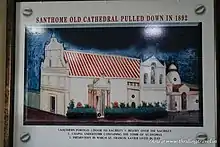
In 1521, the Portuguese in Goa and Bombay-Bassein sent missionaries to Madras (now Chennai) in search of the tomb of Thomas the Apostle, who by local tradition had come to South Asia to preach the Gospel and spread the teachings of Jesus Christ. The site they found was neglected and the Portuguese decided to rebuild the shrine over the tomb. With the support and authority of King John III of Portugal they started building the church, which was consecrated in 1523. Portuguese Padroado priests resumed the daily celebration of liturgy (Holy Mass) at the site.
In 1545, Francis Xavier visited the shrine and lived for about one year in the presbytery of the Santhome Church before he left for his mission in Ilha Formosa (Taiwan). When he lived in the church, he regularly prayed in front of a statue of the Virgin Mother Mary and celebrated Holy Mass; he also prayed regularly at the tomb. The church was made a cathedral in 1606 by Pope Paul V with the creation of the Diocese of Saint Thomas of Mylapore.
British Era

The church was rebuilt in 1896 by the British in the style of Gothic Revival architecture. The place where Thomas is believed to be buried is marked by the second small tower in the centre of the cathedral. Pope Pius XII honoured this cathedral church, elevating it to the dignity and rank of a minor basilica in 1956. Pope John Paul II is the only pope to have visited the church, in 1986. The church was declared a National Shrine in 2004 by the Catholic Bishops' Conference of India, and became known as the National Shrine of Saint Thomas Cathedral Basilica.
Architecture
Santhome Church exhibits the Gothic revival architecture style of the late 19th century. It has a rib vault ceiling made of teak wood, with marble and granite used in other parts of the construction. It was built with 16 windows and 34 stained glass panels, with a main stained glass over the altar representing Thomas the Apostle touching the wound of Christ. The statue in the main altar represents "Thomas the Apostle as priest and Jesus Christ as king". In addition, there are 14 Stations of the Cross attached at the side wall of the cathedral.
The church has two spires. The primary spire, at the left side of the church's entrance, is 45 metres (147 ft) tall. It can be seen from a distance and serves as a bell tower. The second spire rises from the center of the church to indicate the position of the believed tomb of Thomas.

A 200-year-old British pipe organ is installed in the church's gallery, reached by stairs at the entrance.
An adoration chapel adjoining the main church provides for silent moments before the Blessed Sacrament. This chapel can be approached from the left wing of the church apart from an exclusive entrance from the outside.
Observances
Mylai Matha
A gold-painted wooden statue of Mother Mary was brought from Lisbon to Santhome Church in 1523. It is installed at the left side of the church altar and is referred to as Our Lady of Mylapore or, locally, Mylai Matha.
The feast of Mylai Matha is celebrated in December. Worshippers show devotion to Mylai Matha on the second Saturday of the month, with special prayers, procession, rosary and benediction in the evening. The tradition is held to have begun with Francis Xavier.
Pole of St. Thomas
A wooden pole at the church is believed by worshippers to have been washed ashore and erected by Thomas the Apostle. These worshippers believe the presence of the pole saved the church from the 2004 tsunami.
Timeline
- AD 72 – Saint Thomas the Apostle believed to have died in St. Thomas Mount and buried in Mylapore (presently Santhome).
- 1291 – John of Montecorvino visited the believed tomb.
- 1292 – Marco Polo visited.
- 14th century – Franciscan missionaries visited.
- 1425–1430 – Nicolo Conti visited.
- 1517 – Portuguese missionaries arrived in Mylapore.
- 1522 – Construction begun.
- 1523 – Santhome Church was opened.
- 1545 – Francis Xavier visited.
- 1606 – Santhome Church raised to cathedral by Pope Paul V.
- 1893 – British rebuild the Portuguese cathedral.
- 1896 – Santhome Church opened by British with the status of cathedral.
- 1927 – Santhome Church raised to minor basilica by Pope Pius XI.
- 1986 – Pope John Paul II visited.
- 2004 – The church undergoes renovation.
- 2006 – Santhome Church was declared a National Shrine.
Relics
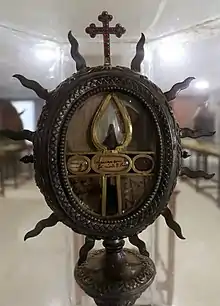
Relics claimed to be held at the church include:
- Bones of Thomas the Apostle
- Spearhead that was used to kill Saint Thomas at St. Thomas Mount
- Holy relic of Francis Xavier
- Holy relic of Bartholomew the Apostle
- Holy relic of Philomena
Burials
- Thomas the Apostle
- Bishop Louis Mathias
- Bishop Antony Devotta
- Archbishop Casimir Gnanadickam
- Archbishop Anthony Rayappa Arulappa
- Archbishop Aruldas
- Bishop Francis Arthur Carvalho
- Dominican Nicholas of Pistoia
- Governor A. J. John
Gallery
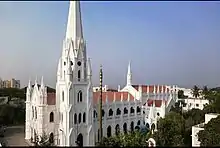 Aerial side view
Aerial side view.jpg.webp) Side view from behind
Side view from behind First spire (bell tower)
First spire (bell tower) Second Spire
Second Spire Cathedral interior
Cathedral interior Evening mass
Evening mass Main altar
Main altar Chairs
Chairs Eagle pulpit
Eagle pulpit High altar statue of Jesus
High altar statue of Jesus Statue of Our Lady of Mylapore
Statue of Our Lady of Mylapore.jpg.webp) Thomas and Jesus
Thomas and Jesus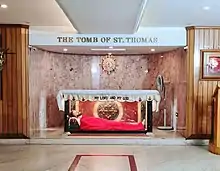 Tomb of Thomas the Apostle
Tomb of Thomas the Apostle
Stained glass
 Left wing
Left wing Main altar
Main altar Lower window
Lower window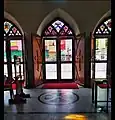 Main entrance
Main entrance Upper window, main altar
Upper window, main altar Upper floor
Upper floor
See also
References
- ↑ "Basilica of the National Shrine of St.Thomas". SanThomeChurch.com. Archived from the original on 26 February 2015. Retrieved 20 February 2010.
- ↑ National Shrine Status Archived 27 February 2009 at the Wayback Machine
- ↑ Santhome Basilica in Chennai — A historical pilgrimage indiastudychannel.com. Retrieved 30 August 2021
